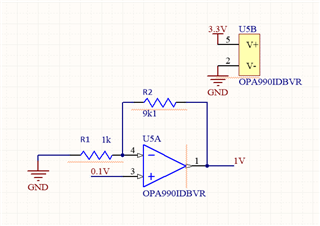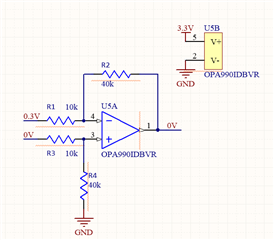Other Parts Discussed in Thread: INA169
Tool/software:
Hello. I am designing a current measurement application using a shunt and an amplifier. I selected the OPA990, but i'm testing it and it doesn't work. This is my circuit:

I have a variable voltage at Vin+ (between 4.5V and 50V). I have chosen that shunt because we don't want a big drop voltage at it at max current (2A):
Vdrop = I · R; V = 2 · 0.02; V = 0,04
So i would need a gain of:
G = Vout/Vin; G = 3.3V/0.04 = 82.5
3.3Vout because of my adc reference.
With this, I have followed the next equations.
R1 = R3
R2 = R4
G = R2/R1 = 82000/1000 = 82
I did the following tests.
- First of all, I supplied 3V3 to the OPAM supply rail. Then, i powered the shunt with 5V. Is a high side current sensor, so I put a power resistor (50R) is series for a little power consumption (I = 5/50 = 0.1A).
- Theoretically, the Vdrop at the shunt will be 2.5mV, so I have to see 2.5 · 82 = 205mV at the output, but I see 3V3.
One of the things I left on my design is the bypass capacitor at VCC/GND, but I think this will not have that big impact in the application.
I have seen in recommened applications bypass capacitors at the inputs of the OPAM, but as the bypass at VCC/GND, I don't think this will have big impact on the design.
I have checked every parameter on the datasheet, as the common mode voltage, because I'm overpassing the VCC voltage at the inputs, but with 1k at 5V, should be enough (I = 5/1000 = 5mA; datasheet recommends less than 10mA). This is a point to improve for voltages above 10V, but multiplying resistor values by 10 will solve this.
- Then, i mounted an isolated circuit outside the board and I powered the OPAM rail and the circuit with 12V. Could this have damaged the circuit even having 12V in the rails and in the inputs with more than 10mA at the input pins?
Am I leaving something out? Is not my first time designing diferential amplificators, but is using this OPAM and a gain this high (the others amplificators I designed were low gain ones).
I don't know if I could have damaged the OPAM doing any test.
Is a problem to power the OPAM with 3V3 and injecting 50V on the input pins even limiting the current at less than 10mA?
Thanks in advance.






